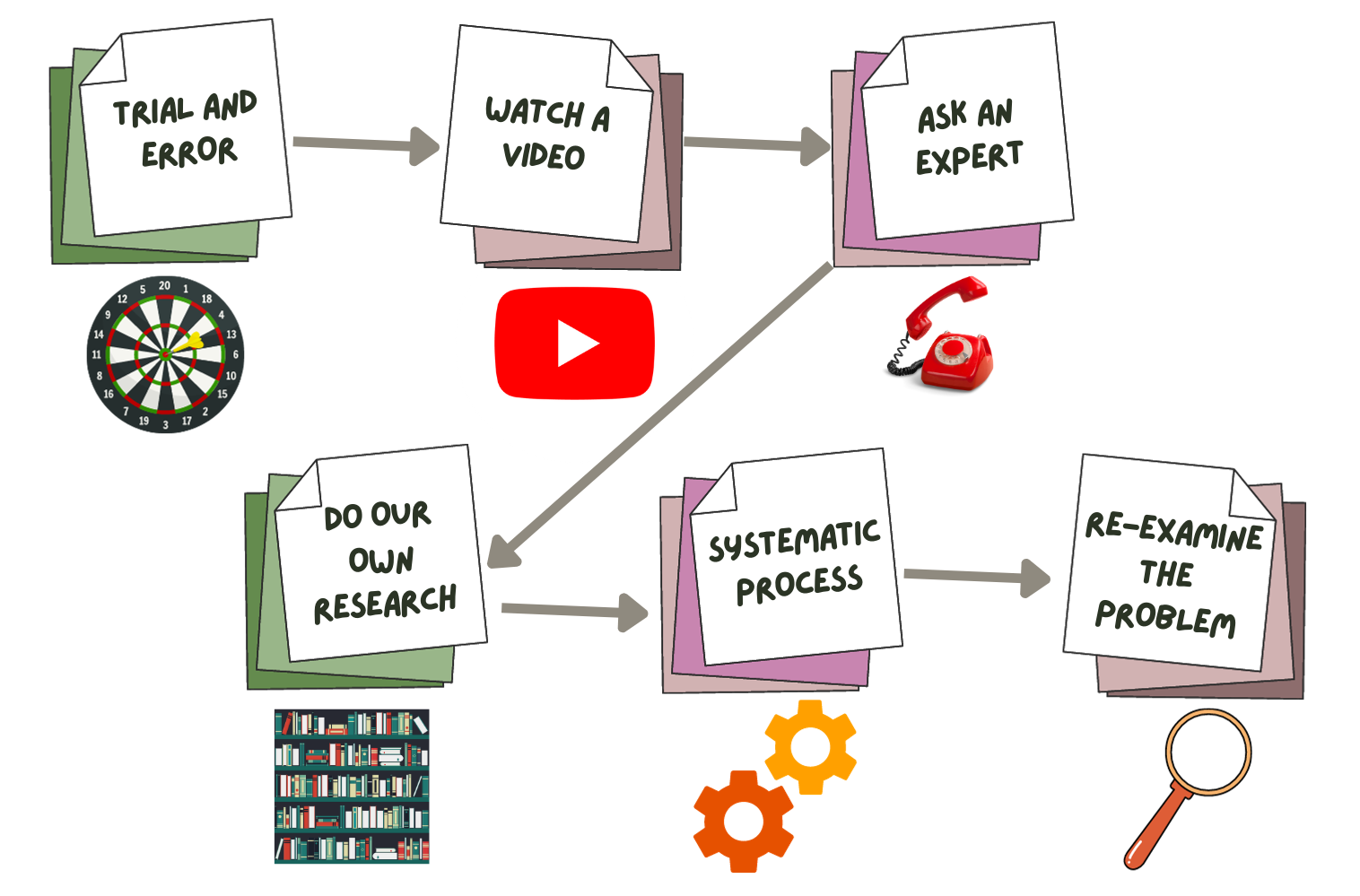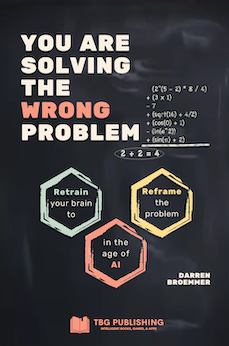From the book "You are Solving the Wrong Problem"Chapter 2: AutoPilot
You live the majority of your life in autopilot. Our brains are wired to function in autopilot mode for the sake of efficiency. We thrive on repeated patterns. We perform daily tasks without much thought, relying on unconscious routine.
In fact, research suggests that people spend over 90% of their time in autopilot mode.
It is a clever survival strategy ingrained in our biology as our brains seek efficiency and energy conservation when dealing with familiar tasks based on experience. This makes it challenging to avoid going down rabbit-holes. We need to retrain our brains to see problems for what they are. Consider the challenges involved in solving a seemingly simple behavioral problem.
Jerry had a habit of using foul language. He wanted to change this behavior. Thus, he decided to change how he handled the next triggering situation. Before he reacted, he would take a deep breath and count to three. This pause would give him an opportunity to consider a more thoughtful response. He could choose how he reacted rather than just doing it. While this approach worked initially, it quickly broke down the next time Jerry felt extremely frustrated.
The proposed solution was straightforward, but numerous factors all need to come together for it to be successful. First, Jerry needed to identify when a triggering situation was occurring. This needed to happen quickly, before his automatic behavioral response kicked in. Then, he needed to exercise patience and follow through on his plan. Only then would Jerry be allowed to process the emotions evoked by the situation before he reacted. Assuming everything had gone well up to this point, he could then choose a more appropriate response. Essentially, Jerry needed to retrain himself to react differently.
If any of these steps broke down, Jerry would not achieve his goal. He might think, "I'll do it right next time." However, the consistent use of bad language may be a symptom of a deeper, underlying issue. There may be other factors influencing his perception of situations. Language is merely a byproduct or manifestation of these underlying problems. To find a long-lasting solution, Jerry must ask questions that address the root cause of his issue. Anything less would be merely scratching the surface.
Changing learned behaviors is a tremendous challenge. Consider the percentage of your life that operates on autopilot. You are rooted in your patterns and habits. These patterns work well most of the time. However, what happens when you face non-trivial issues that don't adhere to familiar patterns? Staying on autopilot in these cases will hurt you. You must retrain your brain to identify situations like this, so that you can shift your focus and adapt accordingly.
Cognitive Behavioral Therapy (CBT) is an entire field of study and treatment that focuses on addressing these issues. The basic idea of CBT is that our brains often rely on pre-programmed responses, operating on muscle memory. To address problems like this, we need to break that cycle. By identifying the old pattern and retraining our minds, we can establish different behavioral patterns.
The Malice at the Palace incident
One of the most infamous incidents in NBA history occurred on November 19, 2004, during a game between the Indiana Pacers and the Detroit Pistons. In this highly charged game, a conflict on the court quickly escalated into a full-blown brawl involving players and fans. Amidst this chaos, Ron Artest, then a player for the Pacers, lay on the scorer's table. He was trying to calm himself down amidst the turmoil. He employed breathing techniques, a method he had been using to manage his emotions and maintain his composure during high-stress situations. These techniques, often used in mindfulness and meditation practices, involve deep, controlled breathing to help reduce stress, lower the heart rate, and promote a sense of calm.
While the surrounding situation unraveled into one of the darkest moments in NBA history, Artest's use of breathing techniques was a personal attempt to distance himself from the immediate aggression and regain his emotional equilibrium. This incident highlighted not only the intensity and unpredictability of professional sports but also the potential of personal stress-management practices like breathing techniques, even in the most heated moments.
It seemed like an odd thing for Ron Artest to do in front of a stadium full of people, but it was a bold attempt to change his behavior. As he lay there, a fan named John Green threw a beer at him from several rows up. Immediately, Artest rushed into the spectator stands and confronted a fan, Michael Ryan, mistakenly identifying him as the instigator. His Pacers teammates quickly joined in, leading to an intensification of the chaos as more beverages and blows were exchanged. This confrontation quickly turned into a widespread melee, spreading from the seating area onto the court and entangling both spectators and athletes from the opposing teams. The match was subsequently abandoned, with law enforcement swiftly summoned to the scene to re-establish control. This intervention was crucial in ensuring the safe departure of the visiting Pacers team from the premises.
In this case, Artest's behavior modification strategy didn't pan out in the end. He got up from the table and started punching people. However, he was making changes. Despite everything going on in the building, Ron Artest was attempting to retrain his brain.
Garbage in, garbage out
"If you keep doing the same things, you will keep getting the same results." -Dave Ramsey
For most of her professional life, Amanda operated on autopilot when it came to networking. She would awkwardly loiter by the snack table at conferences. During introductions, she used mentally rehearsed, stale lines. These habits rarely resulted in meaningful connections, let alone job opportunities. She had a contemptuous view of social media. Who cared if someone was getting a holiday gingerbread mocha at their favorite coffee shop, she thought, as she doomscrolled through her phone.
Amanda was disappointed, as it seemed others in her office had a vast network they could draw upon when needed. At 37 years old, she began questioning whether it was a lost cause. She was an introvert, and she felt inadequate at building her professional network.
Her job was fine, although not very fulfilling. There wasn't a feeling of desperation, in terms of finding a new job, but she felt that her true calling was somewhere else. She had a lot to contribute, but unfortunately, she wasn't given the right opportunities to leverage those skills in her current workplace.
Amanda knew she needed to snap out of her autopilot mentality. She decided to retrain her brain and discard the antiquated notions of networking. Becoming more engaged during social functions was a key goal. Be interested in people and what they have to say. Be your authentic self, and this will attract like-minded people. She reframed the problem as one where she could leverage her strengths and technology. She began to use online networking platforms and post content that was of interest to her, and what she thought may be of interest to others in the field. Over time, she forged valuable connections and eventually got a few job offers though this process. She discovered that, with some authenticity and personalization, networking came more naturally than she thought it would for a shy person like herself.
As Amanda got out of autopilot mode, she learned that introversion didn't need to impede networking. It was a self-limiting belief and autopilot mode that stood in her way. Escaping the shackles of these preconceptions opened up a new pathway for her. She was able to connect with a true, high-value network and experience the joy of new partnerships, innovation, and belonging.
The human-centric approach
Once we identify the need to break out of autopilot mode, the question is what do we do? We need to determine the right path. A typical problem-solving approach looks like the one below.

- Employ trial and error to find solutions and gain insights.
- Tap into the crowd's wisdom on the Internet by running a Google search or watching YouTube videos.
- Seek guidance from an expert or ask friends for advice.
- Conduct your own research to learn more about the problem.
- Apply a systematic approach and break down the problem into manageable pieces.
- Re-examine the original problem with a fresh perspective and alternative methods.
Each of these steps has the potential to provide valuable insights. Naturally, we start with the simplest approach of trial and error. As we progress, we delve into more challenging methods, such as rigorous approaches and thorough re-examination. If a problem cannot be solved quickly or easily, we then resort to techniques that we perceive as mentally demanding. The systematic approach is often considered as a last resort, not to be pursued until other avenues have been exhausted.
This list starts with passive activities and slowly moves into the realm of critical thinking and analysis. We will go over each in detail, but the most fundamental skill to embrace is asking questions. In order to retrain and reframe effectively, you need to ask questions. Not only that, you need to ask questions relentlessly. This is how you get to the bottom of things. This is how you find the root cause.
Once you go beyond the basic Google search, asking questions requires critical thinking as well. Fortunately, we can now ask AI questions. This is particularly helpful, because now we don't have to bug our friends at 3AM when we can't sleep, and are thinking about our problems. The good thing about AI is that it never gets tired of answering us. But we need to know what questions to ask, and how to ask them. Did you know there was skill involved in asking questions?
Chapters
2. Step out of Auto-Pilot Mode
3. Your most important skill: Asking Questions
4. Solve any problem using the Five Whys
5. AI Prompting like a Pro
6. Invention over Convention
7. How to Reframe a Problem to your Advantage
8. The Diamond Pattern: First fan-out, then fan-in
9. The Problem Paradox
10. Break free from Cognitive Bias
11. From Complex to Simple
13. Use AI for Data Analysis
14. The Curiosity Rule
15. Improve productivity by eliminating distractions
16. Optimization Problems
17. Greenfield or work within current constraints
18. Managing the most scarce resource: Time
19. Challenge yourself with Puzzles
20. Next Steps
21. Solutions to Puzzles

